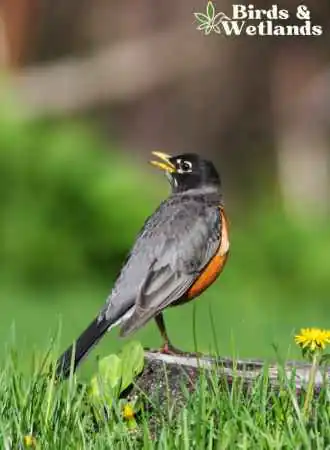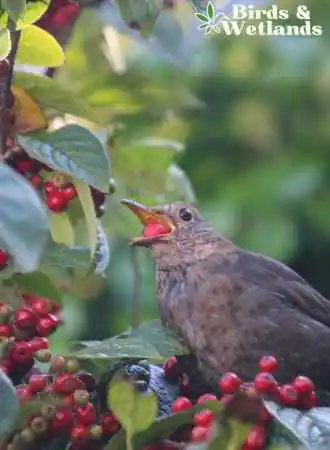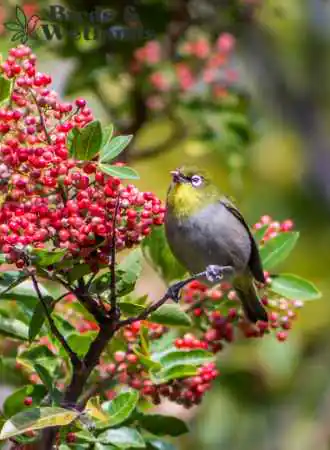Birds are fascinating creatures, and their eating habits are a topic of interest to many people. So do they eat berries?
Many bird species eat berries as part of their regular diet. In fact, berries can provide birds with an important source of carbohydrates and fatty acids, both of which can help them survive better during winter months when food is scarcer.
In this post, we will provide readers with a comprehensive understanding of the topic. We will also explore the types of berries that birds eat, the nutritional value they provide, and the factors that affect a bird’s berry-eating habits.
Whether you are a bird enthusiast or just curious about their eating habits, this post has something for everyone.
Key Takeaways on Do Birds Eat Berries
What type of bird eats berries?

Birds love eating berries. Here are a list of the most common birds that love to munch on berries:
- Cedar Waxwing
- American Robin
- Wood Thrush
- Gray Catbird
- Brown Thrasher
- Blue Jay
- American Goldfinch
- House Finch
- Black-capped Chickadee
- Pine Siskin
Do birds digest berries?
Yes, birds can digest berries as a part of their diet. Many species of birds eat a combination of evergreen and semi-evergreen shrubs that yield red, purple and white fruits. More birds are also attracted to various deciduous shrubs such as viburnums and staghorn sumac.
Berries contain carbohydrates, fats, and proteins, providing birds with energy and essential nutrients. Berries also contain vitamins, minerals, and antioxidants, which are essential for maintaining good health in birds.
Berries can be a significant source of energy and nutrition for many bird species, especially during the breeding season when they require more energy to raise their young.
Some birds, such as thrushes, are specially adapted to feed on berries, and their digestive system is designed to handle large quantities of this food. Other birds, such as songbirds, feed on various foods, including berries, to meet their dietary needs.
Can birds eat nandina berries?

Berries play a crucial role in the diet of many birds. But one particular berry is poisonous to all avian species and other animals — nandina berries.
Nandina berries contain cyanide and other alkaloids that produce highly toxic hydrogen cyanide (HCN). HCN is a colorless, water-soluble gas with a distinct bitter almond odor. Ingestion of even small amounts of HCN can lead to rapid incapacitation and death through respiratory failure.
Do birds eat holly berries?
It is not uncommon to see flocks of birds gathered around a holly bush, feasting on the juicy red berries. Holly plants are widely available in many regions and have adapted from cold to hot climates. This evergreen shrub grows quite rapidly and is a popular landscaping selection due to its vibrant colored berries.
Not only do they enjoy it as a snack, but holly berries are powerful sources of antioxidants that provide energy and help promote healthy immune systems in birds. Whether planted in yards or found in natural locations, backyard birds will surely be drawn towards this bright holly berry feast.
Do birds eat blackberries?

The answer is yes; in fact, for some birds it can be a natural source of food. They typically find blackberry bushes in the wild and consume them whole or peck out the pulpy berry from its core. This type of feeding behavior helps maintain harmony between the bird species and their environment in nature, while also providing sustenance.
Do birds eat raspberries?
Yes, many birds love eating raspberries. For example, American robins, thrushes, cedar waxwings, woodpeckers, warblers and eastern bluebirds will often feast on ripe or partially-ripe raspberries from feeders in backyards across North America. Cardinals have also been known to consume raspberry seeds and the pulp within their natural range. If you want to invite birds to your yard, consider planting raspberries.
Do birds eat honeysuckle berries?

Honeysuckle berries are generally only consumed by birds as an occasional treat or when faced with no other options. These berries are regarded as an inferior food source for avian populations. They are low in fat and lack the necessary vitamins and minerals associated with native berries.
Do birds eat blueberries in the winter?
Winter is a challenging time for birds, especially when resources diminish and temperatures drop. One great way to provide sustenance for wild birds in your area is by planting blueberry bush shrubbery in or near your yard.
Blueberries are a rich source of energy-giving nutrients, especially in the colder months when other food sources may be harder to come by. Numerous birds feed off these plantings throughout winter, including robins, bluebirds, waxwings, and thrushes.
Planting a few blueberry bushes will benefit the local avian population and provide your family with hours of enjoyment watching wildlife flourish around it.
What birds eat berries off of cactus?
The Gila Woodpecker is the only species of bird that acquires its sustenance almost exclusively from a cactus. Its diet consists primarily of insects, but they also feed on berries and the fruit produced by the saguaro cactus. These birds are adapted to living in arid habitats and have evolved not only to find food and shelter amongst cacti but to actually excavate nest cavities in them.
Does planting berry producing plants attract birds?
Yes, planting berry plants can attract birds to the garden or surrounding area. Throughout the year, many birds flock to berry shrubs for the insects they attract and the nutritious fruits they produce. The presence of berry-producing plants can also create a habitat for birds, sheltering them, nesting sites and food.
Different species of plants that produce berries are more attractive to different types of birds. For example, the fruit of the pagoda dogwood tree is favored by species such as the cedar waxwing and the red-eyed vireo, while the fruit of the elderberry is preferred by species such as the robin and the blue jay.
The location of the planting site is also important, as birds are more likely to be attracted to berry-producing shrubs if they are located near their natural habitat. For example, if plant producing blue-black-berries is planted in a wooded area, it is more likely to attract bird species that prefer to live in wooded areas.
In contrast, if the planting site is located in an urban area, native plants may be less effective in attracting birds as fewer birds are present and more competing food sources.
The timing of fruit production is also a key factor in attracting birds to berry shrubs and plants. Birds are more likely to be attracted to plants that produce fruit in the spring or summer when their natural food sources may be limited. It is also important to note that the fruit should be ripe and ready for consumption, as birds are less likely to be attracted to unripe fruit.
What are the best plants that produce berries for birds?
Small trees and shrubs can provide essential food sources and valuable nutrients, and feed birds. If you want to invite avian friends into your garden centers or backyard, consider planting a shrub that produces berries.
Blackhaw

Blackhaw has small, white flowers that bloom in early spring and summer and serve as a popular nectar source for bees, butterflies, and other insects, drawing in birds that are themselves looking for food.
While the berries of the blackhaw can be tasty for some humans, most gardeners cultivate it solely to lure in feathered friends. As an added bonus, the plant’s dense canopy provides shade and shelter from predators during nesting season.
In the spring, a blackhaw can grow into a shrub or small tree, reaching 12 to 15 feet tall and wide.
Winterberry
Winterberry, also known as a deciduous holly, is an easy-to-grow shrub that bursts with vibrant red berries that gleam the winter landscape. Planting these colorful shrubs near a kitchen window or patio can offer year-round entertainment and joy with its lively flock of feathered visitors.
Winterberry attracts birds, including chickadees, waxwings, jays, cardinals and robins—all of which provide a majestic backdrop to the picturesque view of snow-filled branches and brightly colored berries in the winter season. The fruit hangs and ripens in the late fall and winter.
To produce berry fruits, this North American native holly requires a pollinator, so make sure you have both a male and female plant. It thrives in light shade but yields more berries when exposed to full sun.
Bayberry

Bayberry is a deciduous shrub native to Eastern North America. It requires male and female plants to start producing berries. It’s an attractive addition to any backyard, with its dark green leaves, thick foliage and clusters of white or grayish-white berries in autumn.
While humans tend to be quite taken with the bush’s appearance, the birds go wild for bayberry. You can see birds flocking and feasting on its colorful berries during freezing cold winter months when food can be hard to find.
The nutritious fruit serves as sustenance for feathered friends, and its strong aroma helps mask the smell of predators, offering a safer eating experience.
Elderberry
Elderberry is an attractive shrub that produces fragrant white blooms in the early summer and dark berries in the mid-late summer to early fall. It is a popular choice for birds, butterflies, and other wildlife, and it also benefits humans.
Elderberry contains a wealth of vitamins, minerals and antioxidants that can be used as herbal remedies. Sweet-flavored fruits are eaten fresh or cooked and have been known to help boost the immune system. It’s no wonder wild birds are drawn to its bright red-purple berries – it looks like a perfect snack.
Elderberry easily adapts to hot or cold climates and grows best in good soil and full sun. Its glossy leaves and dense branches provide a wildlife wonderland for smaller birds such as northern flickers. It can also be used as a foundation shrub or an attractive specimen in a mixed border.
Cranberry Cotoneaster

Cranberry cotoneaster is a shrub species native to the Himalayan region of Asia and an introduced species in Europe and North America.
It’s an easy-to-grow evergreen with a wonderful, rounded shape and delicate, shiny leaves. Its most attractive feature is its abundant clusters of spring blooms that gradually turn into deep red fruits that last for months after the leaves drop. This provides much-needed sustenance to various species of local birds in the cold winter months, when food can be hard to come by.
It’s also dense enough to provide coverage and shelter, making it a great addition to any backyard oasis. The plant grows in USDA zones 4 through 7 with enough light and a sunny spot.
Red Chokeberry

Red chokeberry is a woody shrub that provides an excellent food source and wildlife habitat for overwintering birds and migrating songbirds. This deciduous shrub has clusters of deep red, edible fruit that improves only after multiple freeze-thaw cycles in winter.
Birds of all sizes flock to it as they pass through our yards, looking for nourishment and protection from cold temperatures. The deep red color of the ripe chokeberries can act as a signal to migrating birds to stop and take notice.


